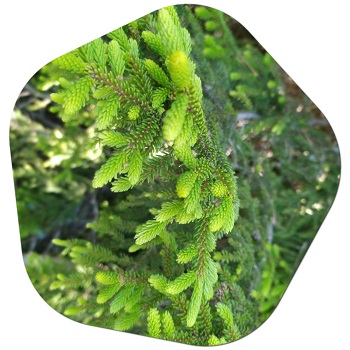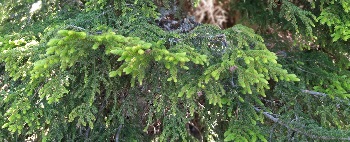Spruce trees are one of the most common tree species in Sweden and can be found in various regions throughout the country. Here are some areas where spruce trees grow in Sweden:
- Boreal Forest: Spruce trees are a dominant species in Sweden’s vast boreal forest, known as taiga. The boreal forest covers a significant portion of northern Sweden, particularly in Norrland and parts of Svealand. Black spruce (Picea mariana) and Norway spruce (Picea abies) are the most prevalent spruce species in this region.
- Southern Sweden: Spruce trees are also found in southern Sweden, although they are less abundant compared to the boreal forest. Norway spruce is the most common spruce species in the southern part of the country, particularly in the southernmost regions of Skåne and Blekinge.
- National Parks and Nature Reserves: Spruce trees can be found in several national parks and nature reserves across Sweden. For example, in the Sarek National Park and Abisko National Park in the Swedish Lapland, spruce trees are a significant component of the forest ecosystems.
- Mountainous Regions: Spruce trees can be found in the mountainous regions of Sweden, such as the Scandinavian Mountains. Norway spruce is commonly found at higher elevations, where the climate is colder and more suitable for spruce growth.
- Coastal Areas: Along the coastal regions of Sweden, particularly in the Baltic Sea archipelagos, spruce trees can be found. They are typically adapted to the coastal climate and grow in sheltered areas.
It’s important to note that the specific distribution of spruce trees in Sweden may vary within these regions based on local climate conditions, elevation, soil type, and other factors. The boreal forest in northern Sweden is the primary region where spruce trees are abundant and have extensive coverage. Are spruce trees found in Swedish forests? >>
Are there spruce trees in Swedish forests?
Yes, spruce trees are commonly found in Swedish forests. Spruce (Picea abies), also known as Norway spruce, is one of the most prevalent and economically important tree species in Sweden’s forests. It is native to the region and plays a significant role in the country’s forestry industry.

Spruce trees are a key component of Sweden’s boreal forest, which covers a large portion of the country. The boreal forest, also known as taiga, is characterized by its dense stands of coniferous trees, including spruce, pine, and birch. Spruce trees dominate large areas of the boreal forest and are often the most abundant tree species in this ecosystem.
Spruce trees in Swedish forests serve various purposes. They are harvested for timber and provide an important raw material for the forestry industry. The wood is used in construction, furniture production, pulp, and paper manufacturing, among other applications. Spruce forests also support biodiversity, provide habitat for wildlife, contribute to carbon sequestration, and help maintain the ecological balance of the forest ecosystem.
It’s worth noting that the specific distribution and abundance of spruce trees within Swedish forests can vary depending on factors such as local climate, soil conditions, elevation, and historical land use.
Are spruce trees suitable for the Swedish climate?
Yes, spruce trees are well-suited to the Swedish climate. Norway spruce (Picea abies), the most common species of spruce in Sweden, is highly adapted to the climate conditions found throughout the country.

The Swedish climate is characterized by cold winters, cool summers, and moderate precipitation. These conditions are favorable for the growth and development of spruce trees. Here are some reasons why spruce trees thrive in the Swedish climate:
- Cold Hardiness: Spruce trees, including Norway spruce, are adapted to withstand harsh winter temperatures. They have developed mechanisms to protect their tissues from freezing, such as dormancy and antifreeze compounds in their cells.
- Winter Survival: Spruce trees have flexible branches that can bend under the weight of snow, reducing the risk of breakage. Their needle-like leaves also help to minimize water loss during the winter months.
- Moisture Tolerance: Spruce trees are well-adapted to the moderate precipitation levels in Sweden. They can tolerate a wide range of soil moisture conditions, including both moist and well-drained soils.
- Shade Tolerance: Spruce trees are relatively shade-tolerant compared to some other tree species. This allows them to grow and thrive in the understory of forests, competing with other trees for light.
- Growth Rate: Spruce trees, including Norway spruce, have a moderate growth rate that is well-suited to the slower growth patterns often observed in northern climates.
Due to these adaptions, spruce trees are a common and successful component of Swedish forests, particularly in the boreal forest regions. They play a vital role in the country’s ecosystem, economy, and cultural heritage.
Are spruce trees cut down without permission in Sweden?
In Sweden, cutting down trees without permission is generally not allowed, and there are regulations and laws in place to protect forests and ensure sustainable management. The Swedish Forestry Act (Skogsvårdslagen) and other environmental regulations govern tree cutting and require appropriate permits or authorizations for tree removal activities. Here are some key points regarding tree cutting permissions in Sweden:
- Ownership and Permissions: Forests in Sweden are primarily owned by private individuals, companies, or the state. To cut down trees, the landowner or the person responsible for the land must grant permission or hold the necessary permits.
- Forestry Planning: Forestry activities in Sweden typically follow a long-term planning process known as “skogsbruksplan” or forestry plan. This plan outlines how the forest will be managed, including any planned tree cutting activities. It helps ensure sustainable forest management practices.
- Felling Permits: Depending on the specific circumstances, a felling permit (avverkningsanmälan) may be required before cutting down trees. This permit is obtained from the Swedish Forest Agency (Skogsstyrelsen) and is typically necessary for larger-scale tree felling activities.
- Protected Areas and Species: Some forests in Sweden may be designated as protected areas or contain protected tree species. Cutting down trees in these areas often requires special permits or permissions due to their ecological or conservation value.
- Local Regulations: Local municipalities or county administrations may have additional regulations or guidelines for tree cutting, particularly in urban areas or specific land-use contexts.
It’s important to note that these regulations and requirements aim to ensure sustainable forest management, protect biodiversity, and maintain the ecological balance of Swedish forests. Violating these regulations can result in legal consequences and penalties.
If you are planning to cut down trees in Sweden, it is advisable to consult with the landowner, forestry professionals, or relevant authorities to understand the specific permissions, permits, and procedures that apply in your situation.
Spruce tree pruning in Sweden
Pruning spruce trees in Sweden follows similar principles and guidelines as pruning spruce trees in other regions. Here are some considerations for spruce tree pruning in Sweden:
- Timing: The best time to prune spruce trees in Sweden is during late winter or early spring, typically from late February to early April. Pruning during the dormant season before new growth begins allows the tree to recover quickly and minimizes stress.
- Dead or Diseased Branches: Remove dead, damaged, or diseased branches as soon as they are identified, regardless of the season. Pruning these branches promotes tree health and helps prevent the spread of diseases or pests.
- Structural Pruning: Structural pruning is typically performed on young spruce trees to establish a strong framework and proper branch structure. It involves removing competing or crossing branches, encouraging a central leader (main vertical stem), and maintaining balanced branch distribution. Structural pruning is usually done during the early years of tree growth.
- Selective Pruning: Selective pruning can be done to improve the tree’s appearance, address safety concerns, or promote better spacing between branches. It’s important to avoid excessive pruning, as spruce trees do not regenerate foliage easily on older wood.
- Pruning Techniques: Use proper pruning techniques when pruning spruce trees. Make clean cuts just outside the branch collar (the swollen area where the branch meets the trunk) to aid in healing. Avoid leaving stubs or making flush cuts. Use sharp and clean pruning tools to minimize damage and the spread of diseases.
- Professional Assistance: If you are unsure about pruning techniques or the specific needs of your spruce tree, consider consulting with a certified arborist or tree care professional. They can provide expert advice tailored to your tree’s condition and help ensure proper pruning practices.
Remember that proper pruning is essential for maintaining the health and aesthetics of spruce trees. It’s advisable to assess your tree’s specific needs and consult with professionals if necessary to ensure the best results.
